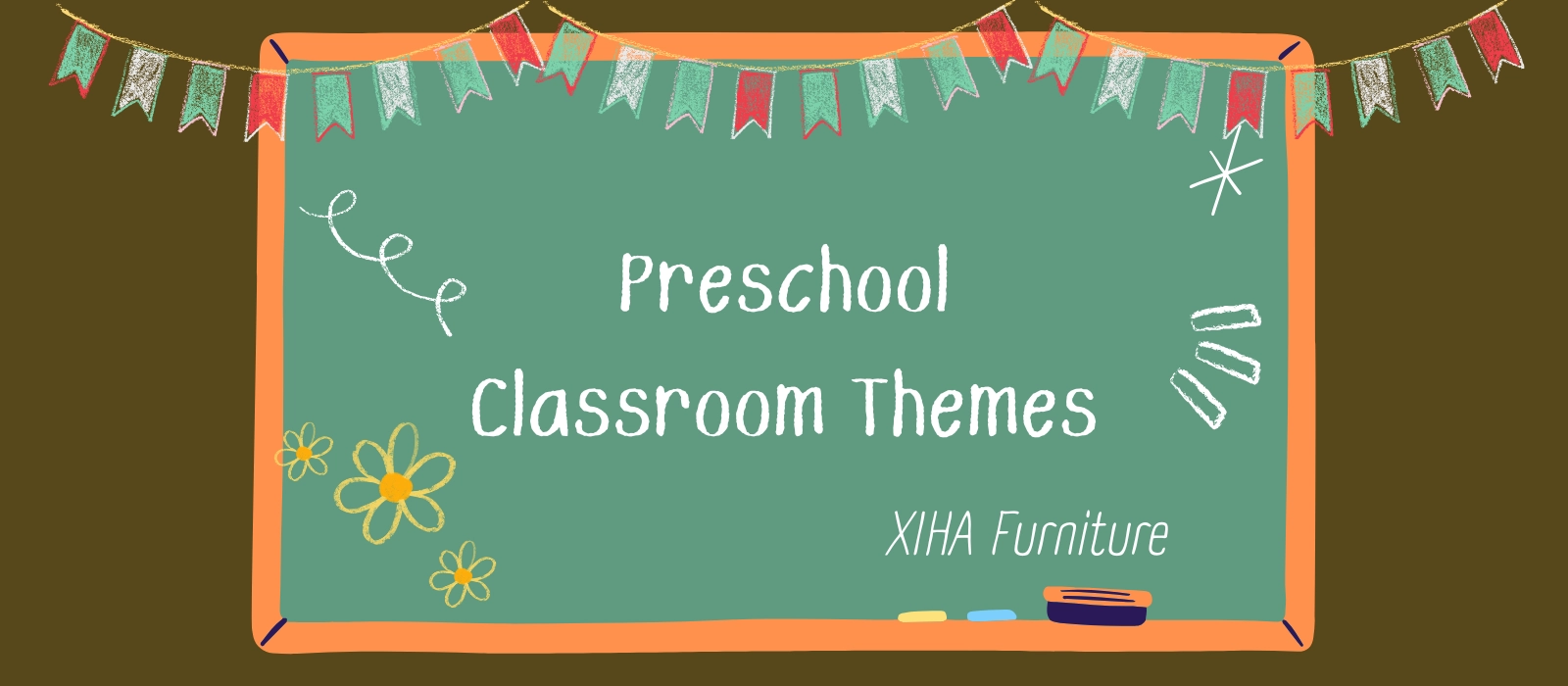Are your preschool classrooms lacking energy and excitement? Do the children seem bored or disengaged with their surroundings? Are you unsure how to create a learning space that inspires creativity, exploration, and joy every single day?
Choosing the right preschool classroom themes can make a huge difference. It’s not just about decoration—it’s about fostering emotional safety, thematic learning, and a sense of belonging. A well-decorated theme-based classroom supports both structured activities and spontaneous learning, helping children feel more connected, curious, and calm in their environment.
Themes can turn an ordinary preschool classroom into an imaginative learning world. From jungle adventures to starry galaxies, the right theme invites children to play, learn, and interact. In this guide, I’ll share 12 of the best preschool classroom themes—ones that are loved by both teachers and children—and how you can implement them in your school or learning space effectively.
What Are Thematic Units?
What Is a Thematic Unit in Early Education?
A thematic unit is a curriculum framework where learning activities are organized around a central theme. This theme acts as a thread that ties together different learning domains such as language, science, math, art, and social skills. Instead of teaching isolated facts, thematic instruction encourages children to make connections between ideas, enhancing understanding and memory.
In a preschool setting, a thematic unit might revolve around topics like “Under the Sea,” “Space Exploration,” or “Farm Life.” Each activity—whether it’s reading a story, building with blocks, or doing a craft—is designed to reinforce the theme and keep children immersed in it across the learning day.
Why Are Thematic Units So Effective?
Thematic units align with how young children learn best—through play, repetition, and sensory-rich experiences. When everything in the environment points toward the same theme, children become more engaged. They understand context better, retain information longer, and feel more involved in their own learning.
This approach also allows teachers to scaffold learning more effectively. For example, a child who’s interested in animals during a jungle theme might naturally build vocabulary, practice counting, and explore new textures through theme-related activities. It’s an integrated, holistic method that supports cognitive, social-emotional, and physical development.
Thematic Units vs. Random Activities
Without a clear theme, preschool learning can become fragmented. One day might be about dinosaurs, the next about weather, and the next about trucks—with no meaningful connection between them. This patchwork can confuse young learners, making it harder to build deep understanding.
With thematic units, learning is purposeful and cohesive. It fosters depth instead of surface-level exposure. Plus, it provides structure for teachers, making planning easier and more intentional.
Benefits of Decorating a Preschool Classroom with Themes
Boosts Engagement and Curiosity
One of the most powerful benefits of preschool classroom themes is the way they boost student engagement. When children walk into a room that looks like a jungle, a space station, or an underwater world, their imaginations ignite. They want to touch, explore, and ask questions. This naturally leads to curiosity-driven learning. Thematic visuals and props act as conversation starters, vocabulary boosters, and problem-solving triggers.
Encourages Emotional Security and Belonging
A consistent theme provides a sense of order and familiarity. Children thrive in environments where they feel emotionally safe. Preschool classroom themes help create a stable, predictable structure that children can connect with every day. When the classroom “feels like home” through cozy designs and theme-based zones, children show fewer behavioral issues and more positive peer interactions.
Facilitates Cross-Disciplinary Learning
Preschool classroom themes are not just visually pleasing—they serve as an instructional strategy. A single theme like “farm animals” can support learning across reading, math, science, music, and gross motor development. For example, counting sheep, singing animal sounds, reading farm stories, and acting out a barnyard scene all reinforce the same topic from different angles.
Makes Classroom Management Easier
A well-organized themed classroom is easier to manage. Children can self-regulate better when they know what to expect. If the art area is always part of the “nature nook,” they quickly learn routines. Themes also simplify transitions—moving from a “space station” reading area to a “rocket ship” quiet zone is more fun than just changing seats.
Builds Parent and Teacher Collaboration
Preschool classroom themes also improve communication with parents. When parents understand the current theme, they can support learning at home with related books, toys, or outings. Teachers can use newsletters and bulletin boards to showcase theme-based activities, helping parents stay informed and involved.
12 Best Preschool Classroom Themes
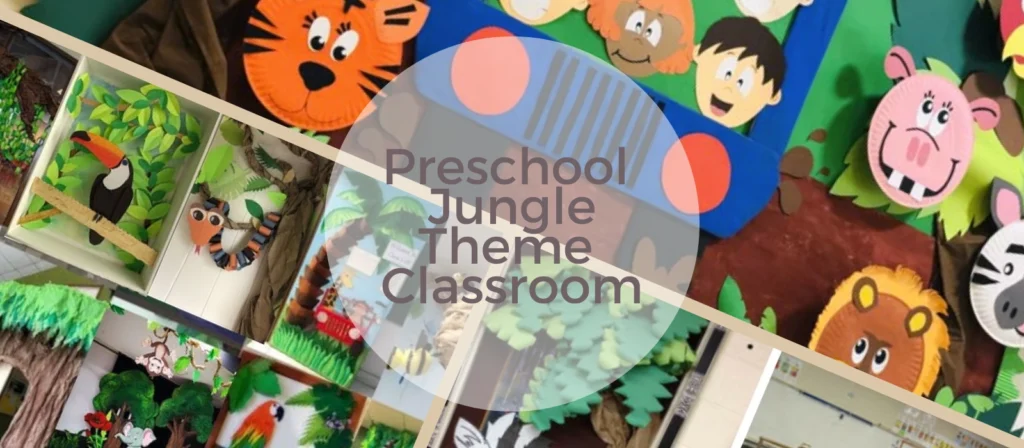
🌿 1. Preschool Jungle Theme Classroom
Transform your preschool classroom into a vibrant jungle adventure filled with monkeys, parrots, vines, and leafy greens. The preschool jungle theme classroom is one of the most popular choices for energetic, nature-loving learners. You can incorporate plush animals, jungle sounds, rainforest plant decor, and sensory bins filled with faux leaves and animals. This theme promotes environmental awareness and introduces young children to biodiversity and conservation ideas in a playful way.
From counting jaguars to reading stories about safari friends, every part of the jungle-themed classroom supports literacy, numeracy, and social skills. Green tones and earthy textures also create a soothing environment that encourages calm and exploration.
This is especially effective for physical play areas or dramatic play zones, where children can roleplay as explorers or veterinarians. Consider labeling items with animal names or thematic icons to support early literacy.
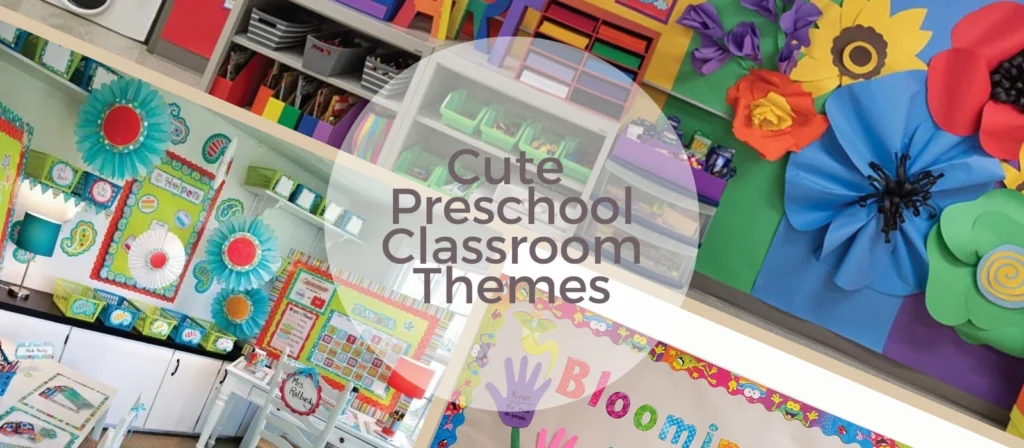
🌸 2. Cute Preschool Classroom Themes
Cute preschool classroom themes are ideal for creating a welcoming, joyful atmosphere that nurtures young learners. These themes often feature pastel colors, smiling characters, and playful shapes like hearts, stars, clouds, and animals. They’re perfect for toddlers and younger preschoolers who are transitioning into group environments for the first time.
Whether you choose a bunny-themed spring setup, a cupcake-themed reading corner, or a “kawaii” inspired art station, cute themes make children feel loved and secure. Soft lighting, fluffy textures, and gentle music enhance the calming effect, making it easier for children to regulate emotions and stay focused.
Cute preschool classroom themes are not just decorative. They play a major role in emotional development by reinforcing a warm, affectionate learning environment. They also work well for reinforcing routines like clean-up time or greetings through themed posters and visual cues.
You can integrate academic activities like counting with cupcakes, sorting with smiley face stickers, or matching pastel letters. Even the alphabet and numbers become less intimidating when presented with cheerful visuals. Use bulletin boards to display children’s cute crafts and positive behavior charts.
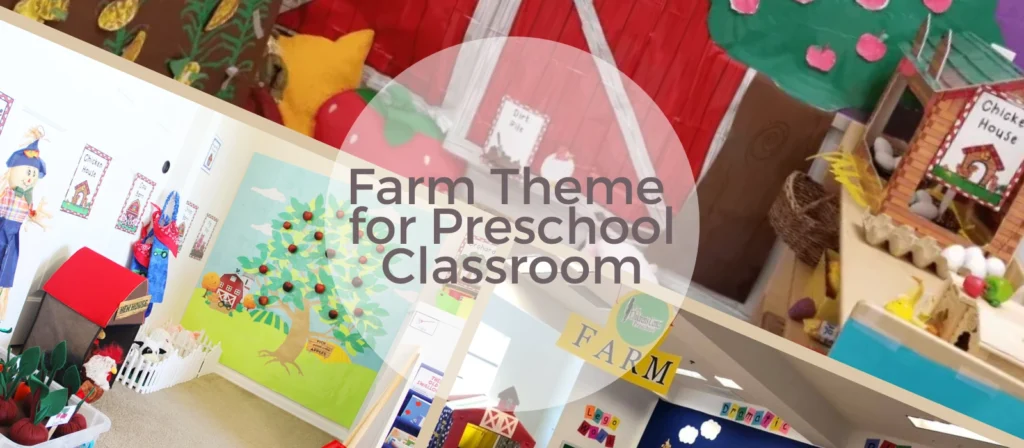
🐄 3. Farm Theme for Preschool Classroom
The farm theme for preschool classroom setups brings a delightful blend of nature, animals, and rural life into the early learning environment. It’s a timeless favorite because it helps children understand where food comes from, introduces them to animals they might not see in urban areas, and offers rich opportunities for sensory, language, and STEM activities.
This theme can include elements like hay bales, red barn cutouts, animal pens, and even pretend tractor stations. Children can sing farm songs, engage in animal roleplay, and create crafts using beans, corn kernels, or felt cutouts. The farm theme for preschool classroom environments is excellent for practicing counting (like sorting eggs or feeding cows), letter recognition (“P” for pig), and science (“What do chickens eat?”).
Teachers can use farm-themed books, puzzles, and hands-on props to immerse children in a structured yet imaginative world. Add a sensory bin with dried corn and plastic animals for tactile play, or build a dramatic play area where kids can pretend to collect eggs or milk a cow.
This preschool classroom theme is especially effective in spring or fall, aligning with agricultural seasons and farm visits. It also pairs well with field trips to local farms or petting zoos.
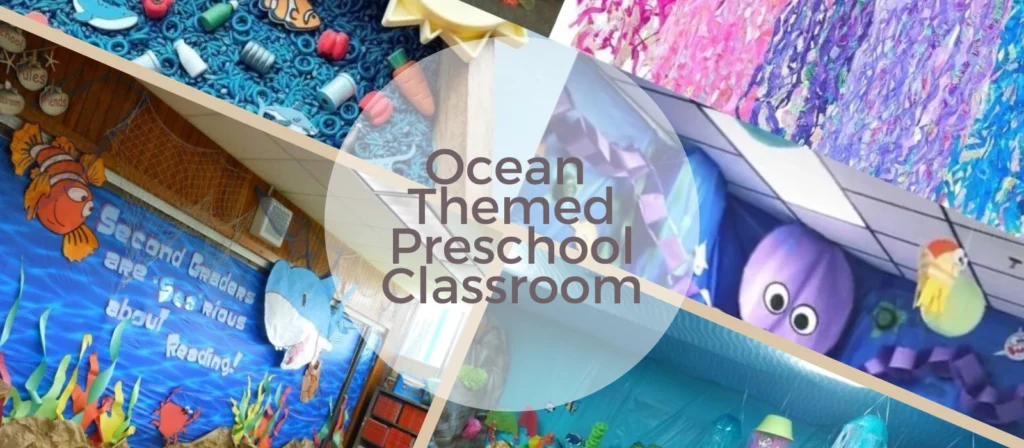
🌊 4. Ocean Themed Preschool Classroom / Preschool Under the Sea Classroom Theme
An ocean themed preschool classroom is one of the most visually captivating and educationally versatile preschool classroom themes. It invites children into a world of waves, whales, and wonder. You can divide your room into thematic zones: a coral reef reading corner, a deep-sea discovery bin, or a sandy dramatic play beach with seashells and toy sea creatures.
This theme supports natural science learning. Children learn about marine animals, ocean layers, pollution, and ecosystems through playful and hands-on experiences. You can use water tables to simulate sea environments, let children match fish shapes, or do craft projects like making jellyfish from recycled materials.
The sensory appeal of an ocean themed preschool classroom is high. With blue fabrics, bubble decorations, and calming ocean sounds, the classroom becomes a relaxing and immersive environment. It also lends itself well to literacy—reading stories like “Rainbow Fish” or “Commotion in the Ocean” reinforces vocabulary and comprehension.
Educational goals for this preschool classroom theme include language development, problem-solving, environmental awareness, and fine motor skills. Teachers can expand the theme by including boat-building STEM activities, class murals of ocean animals, and pretend scuba diving adventures.
This preschool classroom theme also provides a natural opportunity to talk about environmental responsibility, teaching kids the importance of caring for our planet’s oceans.
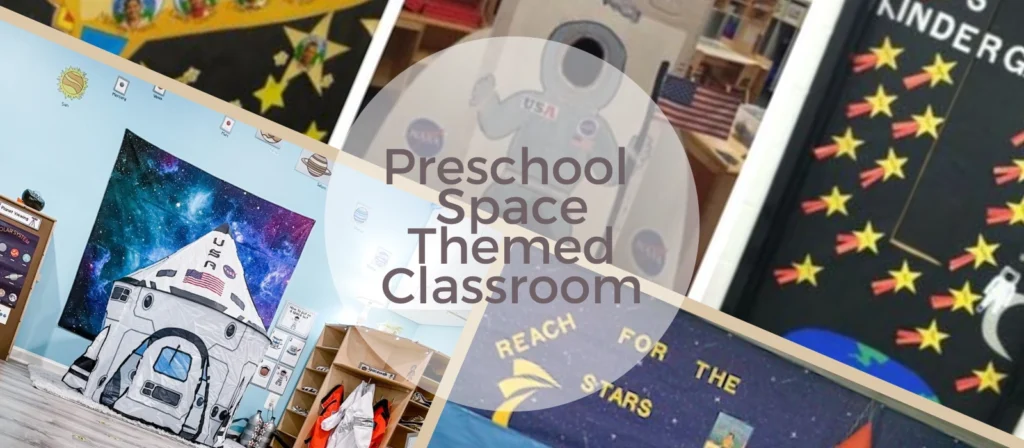
🪐 5. Preschool Space Themed Classroom
A preschool space themed classroom can transport young learners to the stars while building skills in science, math, and language arts. Among all preschool classroom themes, this one sparks endless curiosity about the solar system, astronauts, and outer space exploration. Imagine transforming your classroom into a galaxy with star-covered walls, astronaut costumes, and model planets hanging from the ceiling.
This is one of the most exciting preschool classroom themes for integrating STEM. You can set up a rocket ship reading nook, conduct “moon sand” sensory activities, or build space rovers using blocks and recycled materials. Children can count stars, sort planets by size or color, and learn spatial vocabulary like “orbit,” “launch,” and “float.”
Preschool classroom themes like this one foster imaginative storytelling and dramatic play. Kids love pretending to float in space or speak to mission control. Teachers can use space-themed books, interactive songs, and videos to reinforce concepts about the Earth, moon, sun, and planets.
To enhance visual interest, use dark blue and black backdrops with LED fairy lights to mimic stars. Integrate activities like constellation matching, star name tracing, and building alien habitats using modeling clay. The preschool space themed classroom also introduces early concepts of time (day/night), gravity, and teamwork through astronaut roleplay missions.
This preschool classroom theme makes science approachable, fun, and memorable while reinforcing key early childhood skills.
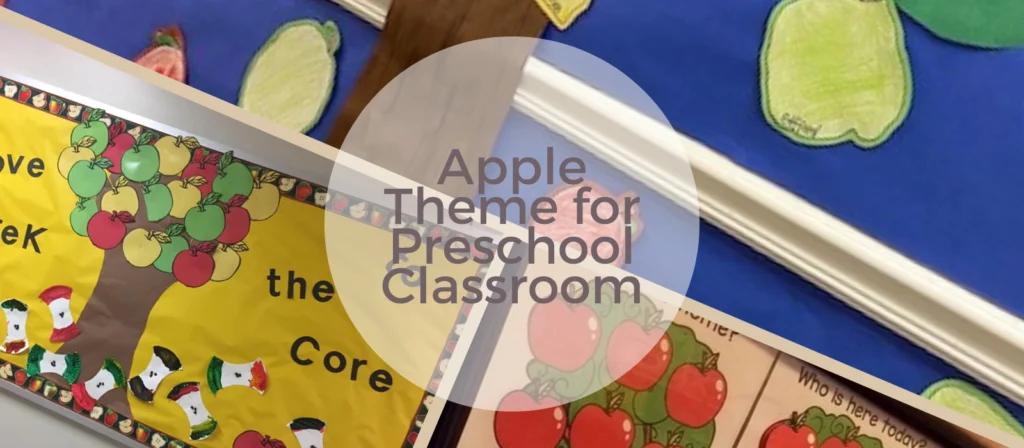
🍎 6. Apple Theme for Preschool Classroom
The apple theme for preschool classroom design is a classic that blends seasonal relevance with foundational early learning goals. Among all preschool classroom themes, this one stands out for its simplicity, familiarity, and versatility. Whether you’re launching the school year or focusing on harvest time, apples offer endless inspiration.
In an apple-themed preschool classroom, you can use red, green, and yellow tones to decorate bulletin boards, reading corners, and learning centers. Add real apples for sensory play, apple counting mats, alphabet apple trees, and themed crafts like torn-paper apples or fingerprint apples. These hands-on activities support early math, language, and fine motor development.
Preschool classroom themes like the apple theme are perfect for integrating science, too. Teach kids about the apple life cycle—from seed to tree to fruit. Use magnifying glasses to examine seeds, or conduct taste tests to compare flavors and colors. This kind of experiential learning deepens understanding and keeps students engaged.
Books like “Ten Apples Up on Top!” and “The Apple Pie Tree” reinforce literacy and thematic vocabulary. Story sequencing, rhyming words, and name recognition activities can all be woven into the apple theme for preschool classroom projects. For dramatic play, transform a corner into a pretend apple orchard with baskets, crates, and farmer hats.
The apple theme is also ideal for developing routines. Use apple icons on name tags, schedule charts, and reward systems. This not only builds a cohesive environment but also makes it easier for children to navigate their day confidently.
Preschool classroom themes that involve familiar, everyday objects like apples help create a bridge between home and school life, encouraging emotional security and excitement for learning.
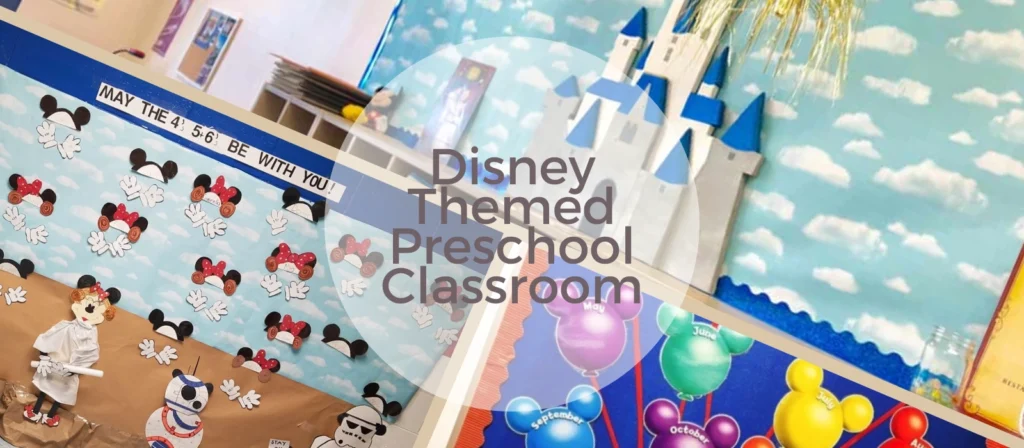
🎬 7. Disney Themed Preschool Classroom
A Disney themed preschool classroom brings beloved characters and magical storytelling into your learning environment. As one of the most emotionally resonant preschool classroom themes, it builds instant trust and enthusiasm because children already recognize and adore Disney characters like Mickey Mouse, Elsa, Simba, or Lightning McQueen.
Incorporating a Disney theme into your preschool classroom means transforming learning centers into fairy tale zones. The reading nook becomes Belle’s library. The building blocks area turns into Radiator Springs. Your dramatic play corner might become Arendelle’s castle or a pirate ship from Peter Pan. Preschool classroom themes that center around well-known narratives are incredibly effective for fostering creative play and language development.
You can rotate sub-themes weekly or monthly—like a Pixar month, a Princess week, or an Animal Kingdom exploration. Use Disney-themed puzzles, number games, alphabet charts, and behavior trackers to create consistency across subjects. This helps reinforce positive routines and expectations through fun, familiar visuals.
For academic enrichment, use themed worksheets—count Olaf’s snowflakes, sort colors with Toy Story aliens, or trace letters from Cinderella’s glass slipper. Preschool classroom themes like Disney spark interest while supporting foundational skills in literacy, numeracy, and emotional development.
Don’t forget music—Disney soundtracks offer rhythmic opportunities for movement, calm-down moments, or circle-time singalongs. Add visuals like castle silhouettes, starry skies, or jungle leaves to complement different Disney settings.
A Disney themed preschool classroom creates a joyful, imaginative learning space where every day feels like a new adventure.
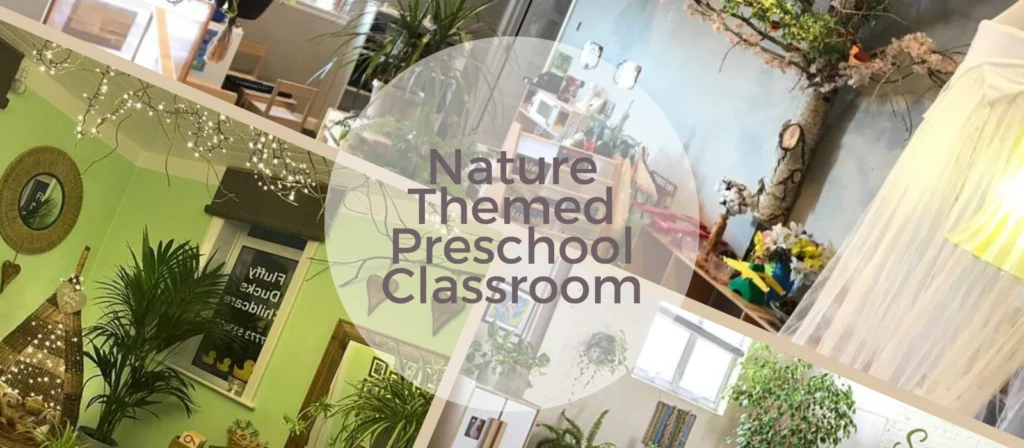
🌳 8. Nature Themed Preschool Classroom
A nature themed preschool classroom is a powerful way to bring the calming, inspiring influence of the outdoors into your indoor space. As one of the most grounding and holistic preschool classroom themes, it encourages curiosity, sensory exploration, and a deep appreciation for the environment.
This theme uses natural colors—greens, browns, blues—and materials like wood, stone, and plants. Preschool classroom themes rooted in nature allow children to connect with their surroundings through touch, smell, and visual stimulation. From pinecones in a discovery basket to a tree branch reading nook, every detail helps bring the outdoors inside.
Nature themed preschool classrooms support science learning through weather charts, plant-growing stations, bug observation kits, and nature journaling. Use leaves, seeds, or rocks in counting games. Create alphabet cards with images of natural elements—“A” for acorn, “B” for butterfly—to strengthen both environmental and literacy knowledge.
Preschool classroom themes that mimic nature reduce sensory overload and improve focus. Natural lighting, gentle sounds like birdsong or water, and textures like soft moss or bark add to the calming ambiance. You can even build a nature-based sensory path on the floor or a “forest fort” reading area.
Classroom management also benefits from nature themed design. Zones can be clearly marked as “meadow math,” “river reading,” or “mountain music” areas to guide movement and support transitions.
Nature themed preschool classroom setups are flexible for year-round use and easy to refresh with seasonal updates—spring flowers, autumn leaves, or winter snowflakes. These preschool classroom themes help build ecological awareness and a lifelong respect for nature.
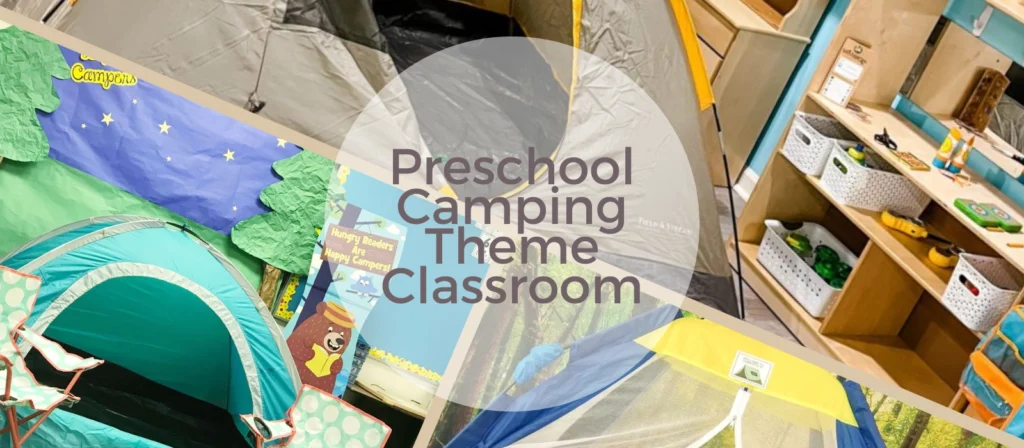
🏕️ 9. Preschool Camping Theme Classroom
The preschool camping theme classroom taps into children’s natural love for exploration, outdoor fun, and imaginative play. As one of the more interactive preschool classroom themes, it transforms the learning environment into a mini wilderness retreat complete with tents, campfires, and woodland critters.
In this theme, you can create cozy reading tents, faux campfires for circle time, and forest-themed sensory bins filled with leaves, twigs, and toy insects. Preschool classroom themes like this invite children to imagine themselves as campers, park rangers, or wildlife explorers, encouraging roleplay, storytelling, and teamwork.
Use nature-based materials to decorate the space—logs for sitting, flannel blankets, lanterns, and animal footprints. You can build academic connections by counting “marshmallows,” identifying animal tracks, or tracing letters with sticks. “Campfire stories” can build narrative skills while promoting group discussion and active listening.
The preschool camping theme classroom also integrates perfectly with themes of survival, community, and nature appreciation. Songs like “Going on a Bear Hunt” or “Camping Song” add rhythm and repetition to daily routines.
Preschool classroom themes like camping work well for extended projects too—build a nature journal, plant mini herbs in a pretend forest, or host a “camp day” with dress-up and snacks. This theme helps reinforce concepts such as safety, respect for nature, sharing, and collaboration.
Best of all, it transforms the classroom into an adventurous, curiosity-driven zone where kids can pretend to toast marshmallows while mastering math, phonics, and social skills.

🦉 10. Preschool Owl Classroom Theme
The preschool owl classroom theme is a cozy, whimsical, and highly symbolic choice among preschool classroom themes. Owls represent wisdom and observation, making them a perfect motif for creating a thoughtful, calm, and academically stimulating environment for young learners.
Decorating a preschool classroom with owls opens up plenty of creative options. Use tree branches, nests, and nighttime skies as your backdrop. Incorporate soft feathers, neutral tones, and nature textures to give your classroom a woodland feel. Preschool classroom themes like this work beautifully with bulletin boards featuring owls reading books, solving math puzzles, or delivering friendly reminders.
Educationally, this theme supports lessons about nocturnal animals, birds of prey, forest habitats, and life cycles. Use owl-themed letter games (like matching uppercase and lowercase letters on owl cards), number sequencing with “hoot” counts, or owl fact scavenger hunts to make learning fun.
Preschool classroom themes based on owls promote storytelling, observation, and nature appreciation. Children can create their own owls using craft materials, roleplay wise old owls in puppet shows, or write short owl adventure stories during literacy time. Teachers can add soft lighting and soothing background sounds like rustling leaves or gentle hoots to create a peaceful mood.
One advantage of the preschool owl classroom theme is its versatility—it can blend easily into fall decor, nature themes, or woodland learning units. It’s also a gender-neutral theme that appeals to a wide range of student personalities.
Overall, owl-themed preschool classroom themes build a nurturing environment where young minds can flourish while engaging with themes of curiosity, awareness, and kindness.
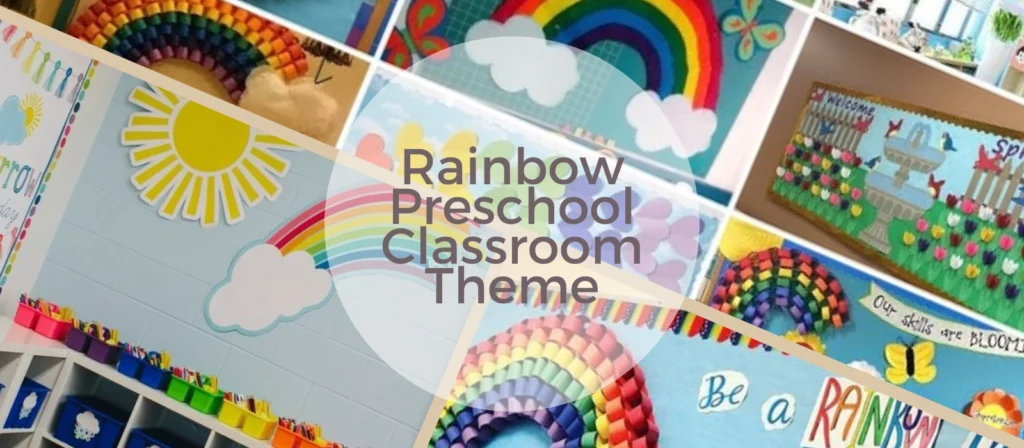
🌈 11. Rainbow Preschool Classroom Theme
The rainbow preschool classroom theme is a vibrant, uplifting, and visually rich environment that delights both children and educators. As one of the most cheerful and versatile preschool classroom themes, it introduces children to concepts of color, diversity, unity, and weather.
Decorating your preschool classroom with rainbows can include colorful streamers, hanging clouds, sunshine crafts, and rainbow rugs. Preschool classroom themes like rainbows encourage sensory stimulation and spatial recognition. Each color band can represent a different learning zone: red for reading, orange for art, yellow for science, and so on.
Rainbow themes also tie seamlessly into lessons about weather patterns, the water cycle, and light refraction. Use prisms, color mixing stations, or weather charts to bring science alive. For literacy and math, try rainbow letter tracing, counting with colored pom-poms, or sorting by color into rainbow baskets.
Preschool classroom themes that focus on rainbows support emotional development, too. The theme’s brightness and visual balance create a welcoming space. Teachers can use rainbows to introduce social-emotional topics like kindness, inclusivity, and uniqueness—emphasizing that every child is a different color in the same beautiful sky.
Use books like “A Rainbow of Friends” or “How the Crayons Saved the Rainbow” for storytime to strengthen thematic learning. Incorporate rainbow songs, dances, and art displays into circle time. Preschool classroom themes that are visually engaging help children focus better and feel excited to explore.
Ultimately, a rainbow preschool classroom theme fosters positivity, color awareness, and cross-subject engagement, making it a joyful and meaningful experience for every learner.
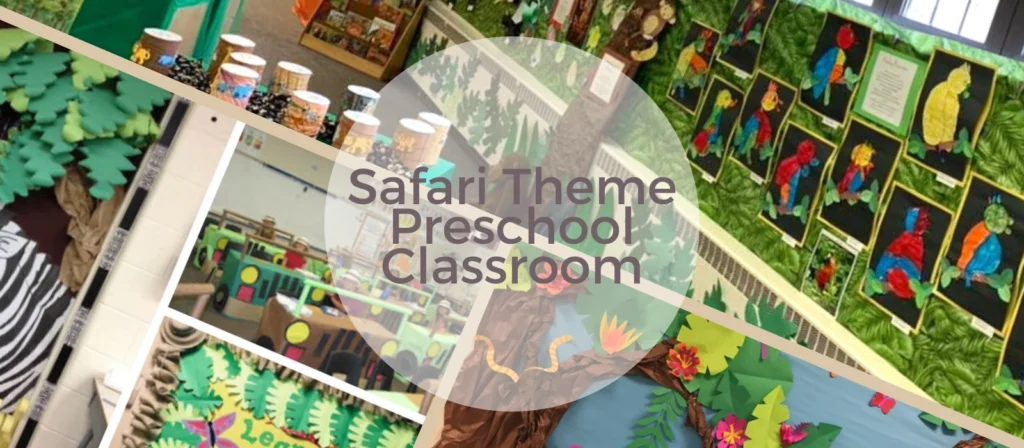
🦓 12. Safari Theme Preschool Classroom
The safari theme preschool classroom brings the thrill of adventure and the excitement of wildlife into everyday learning. Among all preschool classroom themes, this one sparks imagination while introducing kids to the diversity of Earth’s animals and habitats.
Transform your preschool classroom into a wild savannah with animal prints, leafy vines, and plush safari animals. Create themed zones like a jeep-driving center, lion’s den reading nook, and explorer’s tent for dramatic play. Safari-themed preschool classroom themes can include binocular crafts, jungle drums, and sensory bins filled with sand, stones, and toy animals.
This preschool classroom theme encourages inquiry-based learning. Children can identify animal tracks, sort animals by habitat or diet, and listen to sounds from the African plains. Incorporate counting activities with giraffe spots or zebra stripes, or build letter recognition games using animal names.
Preschool classroom themes based on safari adventures encourage movement and expression. Host a “safari walk” around the classroom with clipboards and checklists. Read books like “Giraffes Can’t Dance” or “The Lion Inside” to support literacy goals. Music and movement sessions with jungle beats and animal yoga also enhance gross motor development.
A safari theme also creates opportunities to discuss geography, conservation, and respect for wildlife. Teachers can incorporate globes, maps, and animal classification charts to deepen knowledge.
Preschool classroom themes that involve the natural world help children build empathy for animals and curiosity about the planet. The safari preschool classroom theme is bold, engaging, and full of rich opportunities for cross-curricular exploration.
How to Choose the Right Preschool Classroom Theme
Choosing the best preschool classroom theme can feel overwhelming with so many fun and inspiring options available. To make the right decision, it’s important to balance creativity with educational intention. The right theme enhances not only the visual appeal of your space but also supports classroom management and learning outcomes.
Consider Your Educational Goals
Ask yourself: What do I want my students to learn from this theme? Whether it’s science concepts, emotional development, or literacy enhancement, select preschool classroom themes that align with your curriculum goals. For example, a nature theme is great for hands-on science, while a rainbow theme can support color recognition and inclusion topics.
Reflect on Student Interests and Developmental Stage
Preschool classroom themes are most effective when they resonate with the children. Think about the age, personalities, and current interests of your class. Younger preschoolers may enjoy more visually stimulating themes like cute animals or colors, while older children might engage better with story-driven or roleplay-heavy themes like space or safari.
Match with Seasonal and Cultural Context
Themes tied to seasons or cultural moments—like apples in the fall or camping in the summer—can reinforce real-world awareness and make learning more relevant. Preschool classroom themes that reflect holidays, festivals, or local events also help foster cultural understanding.
Think About Practical Setup and Maintenance
Consider what materials you have or can access easily. Some themes require more complex props or decorations (like space or jungle), while others (like apples or owls) can be created with basic classroom supplies. Make sure your theme is sustainable and easy to keep organized throughout the duration.
Use Flexibility and Thematic Integration
You don’t have to stick with one theme forever. You can rotate themes monthly or quarterly to keep the classroom fresh and stimulating. Choose preschool classroom themes that are broad enough to integrate different subject areas and can be adapted for varying attention spans and learning styles.
By considering these factors, you can choose a preschool classroom theme that energizes your teaching, excites your students, and strengthens the educational journey.
Tips for Implementing Preschool Themes Effectively
Even the most exciting preschool classroom themes will fall flat without thoughtful implementation. To maximize engagement and learning, teachers need to integrate themes into daily routines, classroom management, and developmental goals—not just the decor. Here are essential strategies for making your preschool classroom themes truly effective:
Align Themes with Daily Learning Goals
Your chosen preschool classroom themes should naturally tie into your planned objectives for language, math, science, social-emotional learning, and motor skills. For example, if you’re using a camping theme, create word walls with camping vocabulary, count toy marshmallows, or act out bear stories for drama and comprehension.
Create Thematic Learning Centers
Design each area of the classroom to reflect different aspects of your preschool classroom theme. A safari classroom might have a binocular craft station, a jungle book nook, and a wildlife puzzle table. This allows children to explore the theme from multiple perspectives and disciplines.
Involve Children in the Setup
Give students ownership of their learning space. Let them help hang decorations, make theme-related crafts, or choose items for the dramatic play area. Preschool classroom themes become more meaningful when children participate in bringing them to life.
Use Real Materials and Sensory Elements
Children thrive on sensory input. Add real-life props like leaves, wood, sand, feathers, or fruit depending on your theme. This boosts engagement and supports sensory development while deepening theme immersion.
Rotate Mini-Themes Within the Big Theme
Preschool classroom themes can remain fresh by rotating sub-themes weekly or bi-weekly. Within a nature theme, explore trees one week, insects the next, and birds after that. This keeps curiosity alive without needing a full classroom redesign.
Document and Share Progress
Use portfolios, bulletin boards, and photo displays to document children’s learning through themes. This helps parents stay connected, reinforces learning, and gives kids pride in their work. Label student work with both the theme and the skill being practiced.
Build Transitions Around the Theme
Smooth transitions using your preschool classroom theme. For example, use a “blast off” countdown to switch from space play to clean-up time. Or play safari music to signal circle time. Consistency and fun improve cooperation.
By embedding preschool classroom themes deeply into your daily schedule and learning objectives, you create an environment that’s not only beautiful—but also functionally effective for development and growth.
Common Mistakes to Avoid When Choosing Preschool Themes
Even with the best intentions, some preschool classroom themes fall short due to avoidable errors in planning and execution. Here are some of the most common mistakes to watch out for:
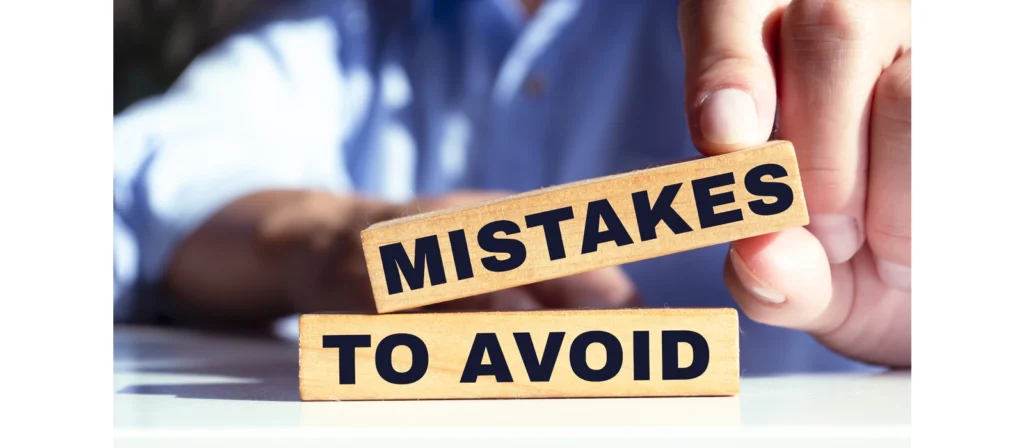
Choosing a Theme Without a Learning Purpose
While it’s tempting to select a theme based solely on visual appeal or trendiness, themes should support educational outcomes. Preschool classroom themes that lack academic or developmental relevance can lead to shallow engagement and wasted time.
Overloading the Environment
Too many decorations, clashing colors, or overwhelming visuals can overstimulate children. A cluttered environment can distract from learning and create anxiety. Make sure your preschool classroom theme is organized, balanced, and calming.
Ignoring Age Appropriateness
Not all themes fit every age group. Complex topics or intense imagery may confuse or scare young learners. Choose preschool classroom themes that align with your students’ developmental stage and cognitive abilities.
Lacking Diversity or Inclusion
Themes that rely on narrow cultural symbols or media representations may unintentionally exclude some children. Select inclusive preschool classroom themes that reflect different backgrounds, experiences, and identities.
Failing to Involve Students
When children don’t participate in creating or shaping their classroom space, they may feel disconnected. Preschool classroom themes are most effective when students help bring them to life—through art, storytelling, or hands-on setup.
Not Rotating or Refreshing Themes
Using the same theme for too long can lead to boredom. Children need novelty to remain curious and engaged. Consider rotating preschool classroom themes every few weeks or tying them to seasons or student interests.
Forgetting Practical Logistics
Themes should work within your space, budget, and time. Avoid choosing preschool classroom themes that require constant upkeep, expensive props, or hard-to-find materials.
Avoiding these mistakes helps ensure your preschool classroom themes are enriching, inclusive, and enjoyable for every student.
Conclusion
Choosing the right preschool classroom themes is more than just decorating—it’s a strategic tool that inspires curiosity, supports learning, and promotes emotional well-being. With thoughtful planning, creativity, and flexibility, educators can transform any space into a joyful, meaningful learning environment.
At XIHA Furniture, we specialize in designing and supplying preschool furniture that complements all classroom themes. Whether you’re building a jungle, a rainbow corner, or a space station, our furniture solutions support your vision.

